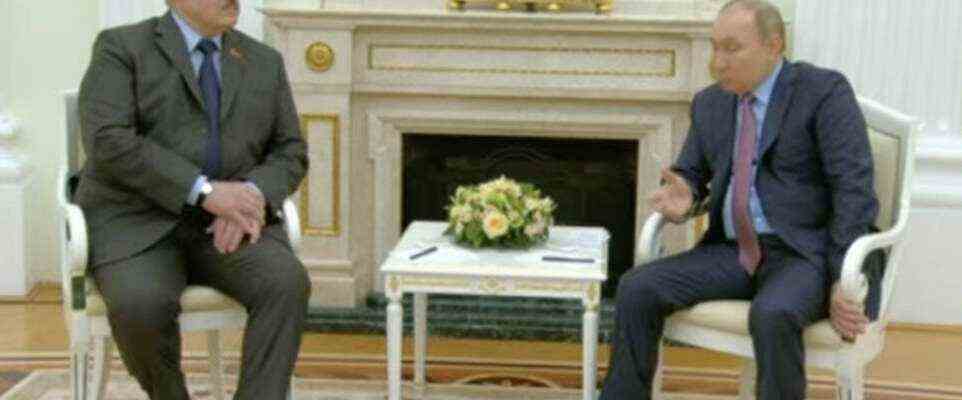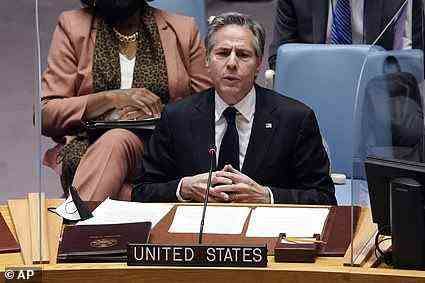Russia will carry out wide-ranging missile drills tomorrow including around Crimea and the Black Sea that will involve launching ballistic and cruise missiles and involve its nuclear forces, the Kremlin has announced.
The exercise, which will be overseen by Vladimir Putin himself, will involve Russia’s aerospace forces, its strategic missile command, Northern and Black Sea fleets and the Southern Military District – which covers Crimea and part of the border close to rebel-held areas in Ukraine.
It is designed to test the ‘readiness’ of commanders and troops as well as ‘the reliability of weapons of strategic nuclear and non-nuclear forces’ and will involve the launch of ‘ballistic and cruise missiles’, Moscow’s defence ministry said today.
Officials claim the drill is pre-planned, but the timing will spark fears that it is designed to provide cover for an invasion of Ukraine. Experts predict the first phase of a Russian assault will be ballistic missile attacks on border areas, military bases, infrastructure and major cities.
It comes as defence ministers meet in Munich for a security conference that will begin today and continue over the weekend aimed at averting war in Ukraine. Russia will not send a delegation to the summit, marking the first time in years that it has not attended.
The historical parallel with the 1938 Munich Agreement – an attempt at appeasement with Hitler’s Germany that failed to avert the Second World War – could hardly be more poignant or chilling.
Shunning the West, Putin instead spent Friday meeting with Belarusian dictator Alexander Lukashenko in Minsk – who announced he will help oversee the drills on Saturday.
Lukashenko, who for many years resisted welcoming Russian troops to his country, has now allowed thousands in to stage joint drills at military bases and has even floated the idea of changing the country’s constitution to allow nuclear weapons to be stationed there.
As diplomats gathered, Russia continue to push claims of ‘genocide’ in Ukraine’s Donbass region that the West warns will likely be used as a pre-text to attack. Last night, at the UN, Russia presented papers alleging 9,000 civilians including 126 children have been killed by Ukrainian forces. The claims have not been verified.
Meanwhile Britain’s Ministry of Defence outlined how it believes a Russian invasion will play out, noting that over half of Moscow’s forces near Ukraine have been moved to within 30 miles of the border. Ukraine warned today that the total number of troops now stands at 149,000.
Elsewhere today…
- US President Joe Biden will hold talks with Britain, Canada, France, Germany, Italy, Poland, Romania the EU and NATO allies on Friday to discuss the crisis, European sources said
- Shelling continued along the frontlines between Ukrainian forces and Moscow-backed rebels in the country’s east, following the heaviest day of shelling in the last four years on Thursday
- Ukraine accused rebel commanders of launching ‘unprovoked’ attacks, while the rebels continued to insist they are the ones being shot at
- Sergei Lavrov, Russia’s foreign minister, accused international groups monitoring the clashes of trying to ‘conceal’ what is going on and said rebel forces are being shot at with banned weapons
- Lloyd Austin, US defence secretary, arrived in Poland where he announced the sale of Abrams tanks to Warsaw and again accused Russia of lying about withdrawing its forces from Ukraine’s borders
Vladimir Putin and Alexander Lukashenko meet at the Kremlin today, as Russia announced major missile drills to take place tomorrow which will be personally overseen by the two men
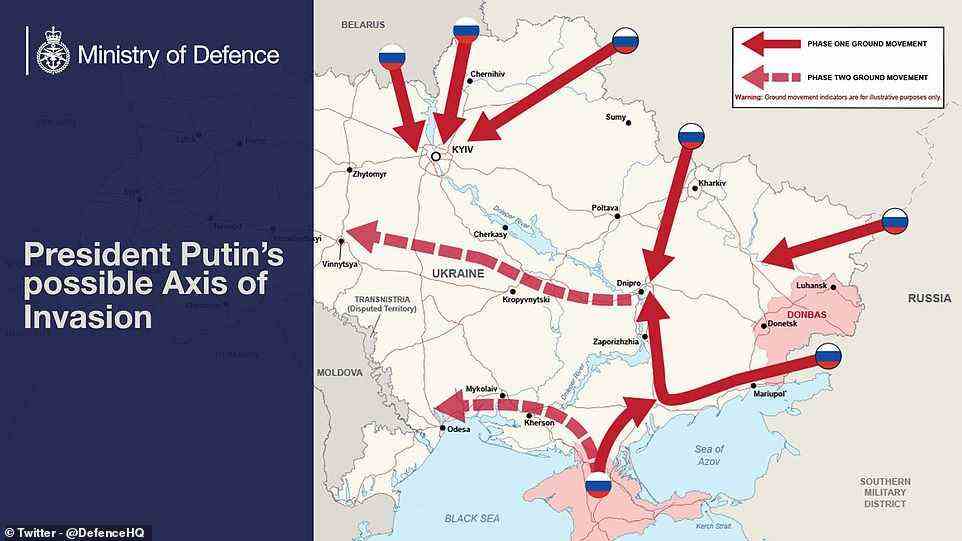
The report said Putin has massed troops on Ukraine’s northern border in a way that ‘directly threatens Kiev, the capital’ and showed a series of possible routes Russian soldiers could take in an invasion that could see them take much of the east of the country
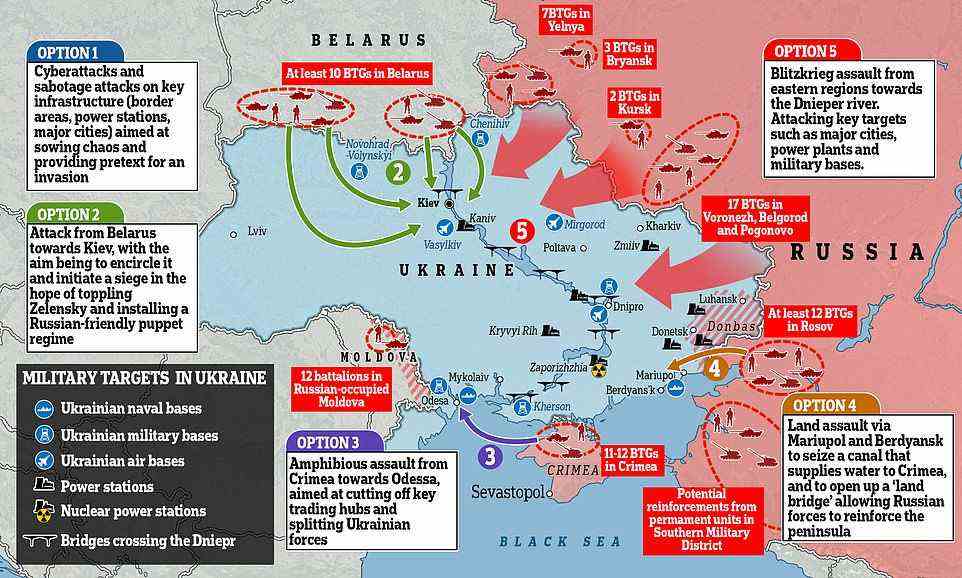
A map showing where Putin’s forces have assembled on Ukraine’s borders, the military options Putin might be considering, and key targets he would likely go after in the event he chooses to invade – something the US continues to war could be just weeks away from happening
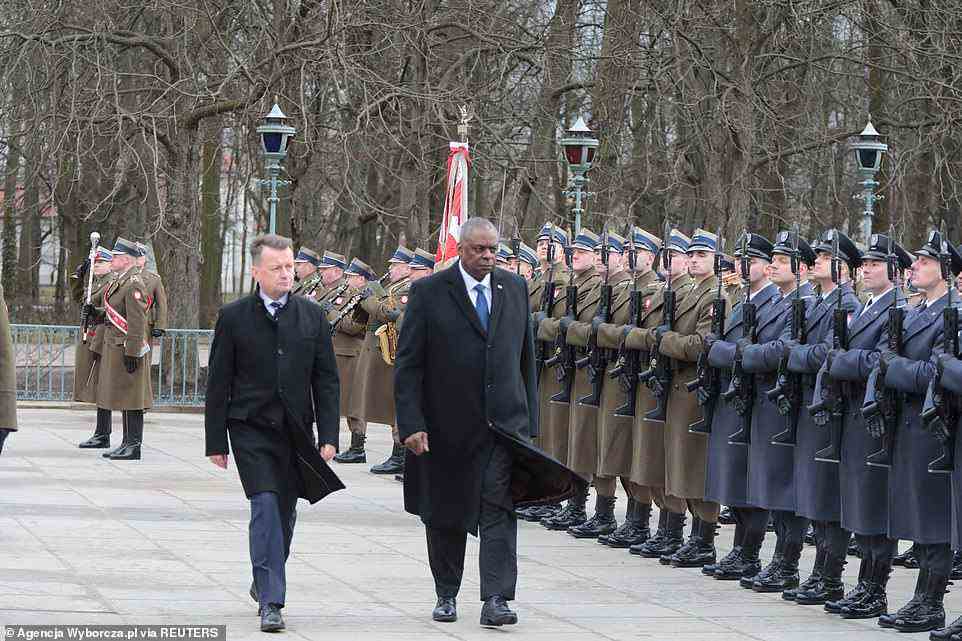
U.S. Defense Secretary Lloyd Austin and Polish Defence Minister Mariusz Blaszczak attend a welcoming ceremony before their meeting in Warsaw, Poland
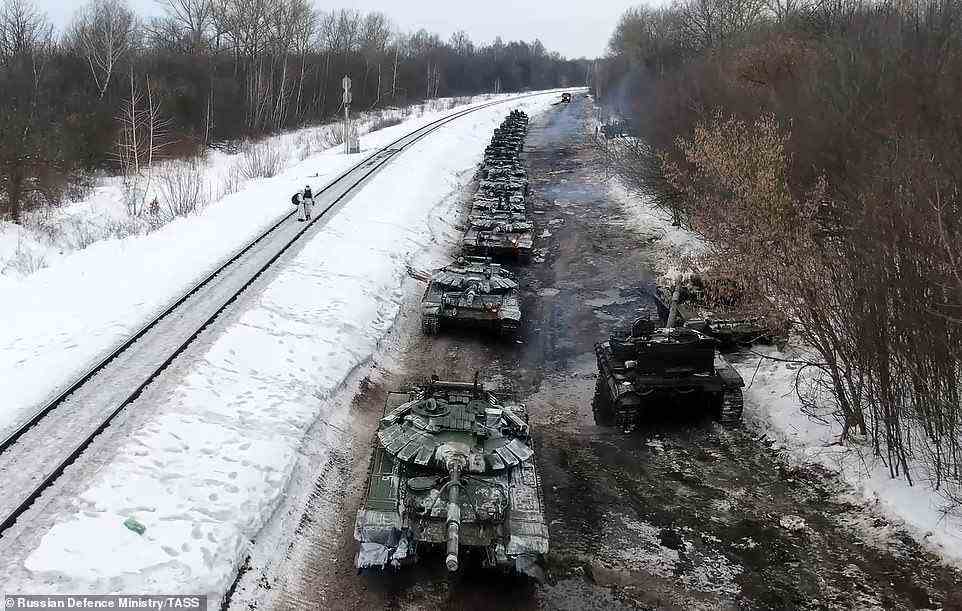
Russian tanks are pictured lining up beside railway tracks to be loaded on to transports in what Moscow claims is a withdrawal of forces from Ukraine’s borders, but the West says are actually units moving closer to the frontlines
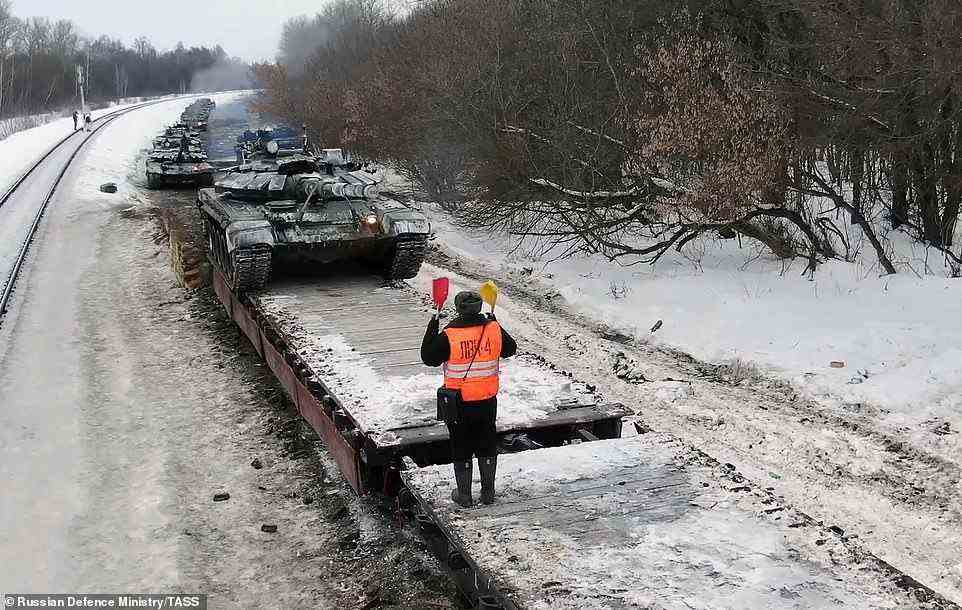
Russian T-72B tanks are loaded on the back of a train at an unknown location on the border with Ukraine, as Kiev warns troop numbers in the region have now reached 149,000

A top-down view of a Russian T-72B tank shows it being loaded on to the back of a train transport somewhere near Ukraine
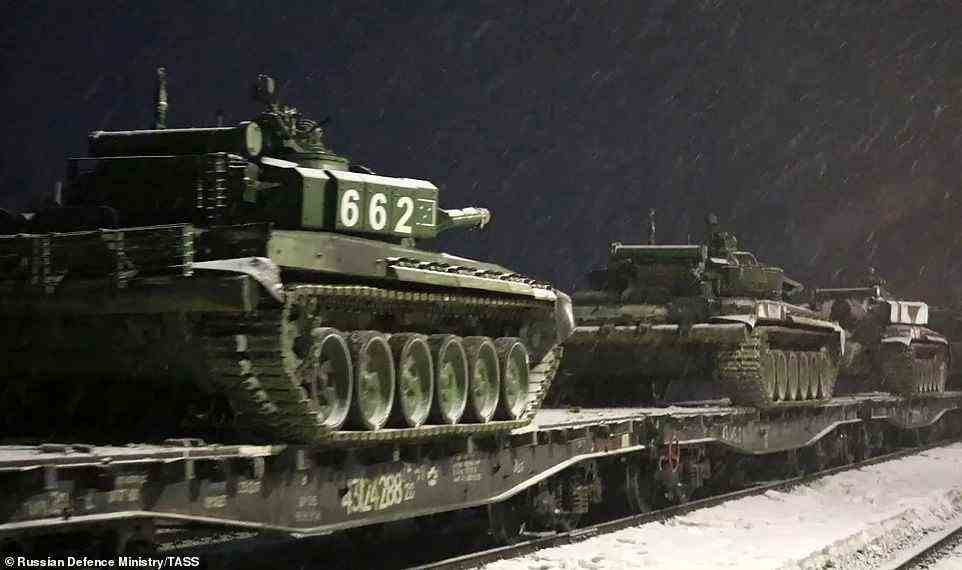
A video released by Russia’s defence ministry shows tanks loaded on to the back of a train transport somewhere near Ukraine

The UK has warned that more than half of Russia’s forces near Ukraine are less than 30 miles from the border, despite Moscow claiming to be pulling back (pictured, tanks on a transport somewhere near the border)
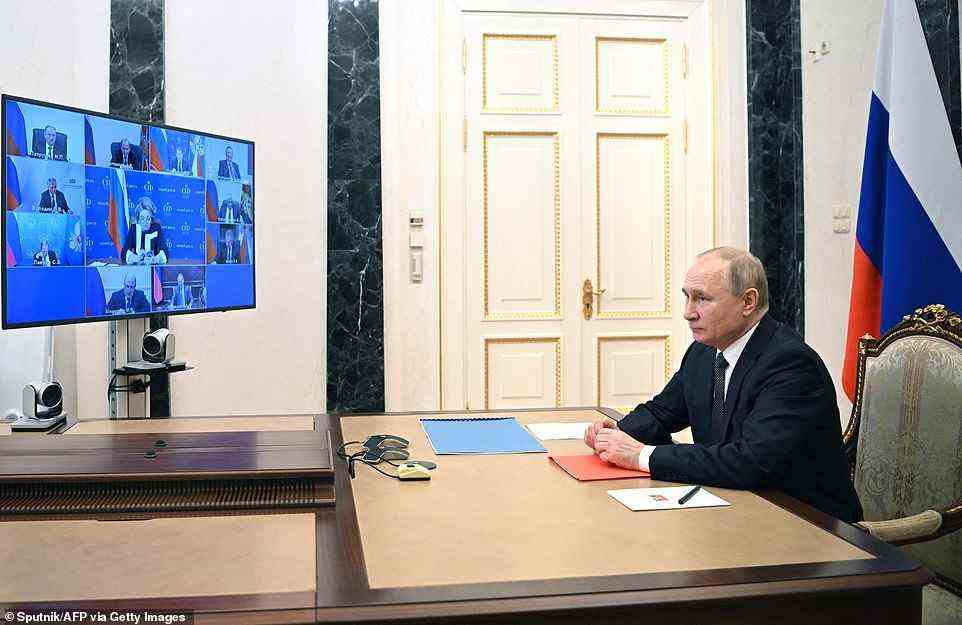
Vladimir Putin chairs a meeting with members of his security council today, amid continued warnings from the West that a Ukraine invasion is now just days away
Putin has massed troops on Ukraine’s northern border in a way that ‘directly threatens Kiev, the capital’, said the MoD report, which showed a series of possible routes Russian soldiers could take in an invasion that could see them take much of the east of the country.
It warned there would be ‘considerable’ civilian casualties in the event of war and that Putin ‘would be willing’ to sustain the losses ‘to get what he wants’.
Ukrainian President Volodymyr Zelenskiy, U.S. Vice President Kamala Harris and NATO Secretary-General Jens Stoltenberg will be among the dignitaries attending the three-day event, known as ‘Davos for defence’, which kicks off on Friday at the Bayerischer Hof hotel in Munich.
No Russian delegation will attend the conference, the Kremlin said last week – the first no-show in years, underscoring how much East-West relations have deteriorated.
Even at the height of the Ukrainian revolution preceding Russia’s annexation of Crimea, Russian Foreign Minister Sergei Lavrov attended. Russian Foreign Ministry spokesperson Maria Zakharova said the forum had increasingly become biased towards the West, ‘losing its inclusivity, objectivity’.
Daniela Schwarzer, a senior fellow at Harvard Kennedy School’s Belfer Center, said: ‘Russia has limited interest in dialogue and in particular an open conversation about security in Europe.
‘The conference is an occasion for the political West to show unity vis-a-vis Russia and vis-a-vis authoritarian regimes more generally.’
U.S. President Joe Biden said on Thursday there was now every indication Russia was planning to invade Ukraine in the next few days and was preparing a pretext to justify it, after Ukrainian forces and pro-Moscow rebels traded fire in eastern Ukraine. The Kremlin accused him of stoking tensions and threatened unspecified ‘military-technical measures’.
Schwarzer noted that the conference, while scaled back compared to pre-pandemic ones, would be the first physical meeting of the international security and foreign policy community in two years. In-person conversations were key to ‘building trust’, she said.
The Ukraine standoff is not the only crisis that will keep conference attendees busy. Roundtables on Saturday, the main day of events, will also address the fragile security situation in the Sahel and the revival of Iran’s 2015 nuclear deal.
Conference Chairman Wolfgang Ischinger told reporters he could not recall a time when there were ‘so many overlapping crises’.
On Friday, the main program kicks off from 1230 GMT with speeches by U.N. Secretary General Antonio Guterres, German Foreign Minister Annalena Baerbock and U.S. Secretary of State Antony Blinken.
Ahead of conference’s opening ceremony, Ms Baerbock said Moscow needed to show ‘serious steps towards de-escalation’.
‘With an unprecedented deployment of troops on the border with Ukraine and Cold War demands, Russia is challenging fundamental principles of the European peace order,’ Baerbock said in a statement.
Foreign ministers from the Group of Seven club of rich nations – including France, Britain, the US and Japan – will discuss the Ukraine crisis on the conference sidelines Saturday.
The talks will be hosted by Baerbock, whose country currently holds the G7 presidency.
‘Even tiny steps towards peace are better than big steps towards war. But we also need serious steps towards de-escalation from Russia,’ she said.
‘Declarations of willingness to talk must be backed up by real offers to talk. Declarations of troop withdrawals must be backed up by verifiable troop withdrawals.’
Also on Friday, US defence secretary Lloyd Austin was paying a visit to Poland – which neighbours Ukraine and is where thousands of US troops and permanent American missile bases are stationed – as a show of support.
After a welcome ceremony in the capital Warsaw, Austin dismissed Russian assertions that forces are being withdrawn from areas around Ukraine and said the United States was committed to the defense of NATO allies.
‘What Mr. Putin did not want was a stronger NATO on his flank, and that’s exactly what he has today,’ Austin told a press conference after announcing the planned sale of Abrams battle tanks to NATO member Poland.
Mr Blaszczak said that Poland will be willing to help refugees displaced by the fighting, amid warnings that up to a million people could flee across the border if war breaks out.
Meanwhile Polish Prime Minister Mateusz Morawiecki told a summit in Brussels that sanctions being prepared for Russia in the event of an attack would be harsher than those imposed after the attack on Crimea in 2014.
Elsewhere, the Ukrainian military and independent conflict monitors reported a large uptick in fighting along the frontlines between Kiev’s forces and separatist rebels in the country’s east.
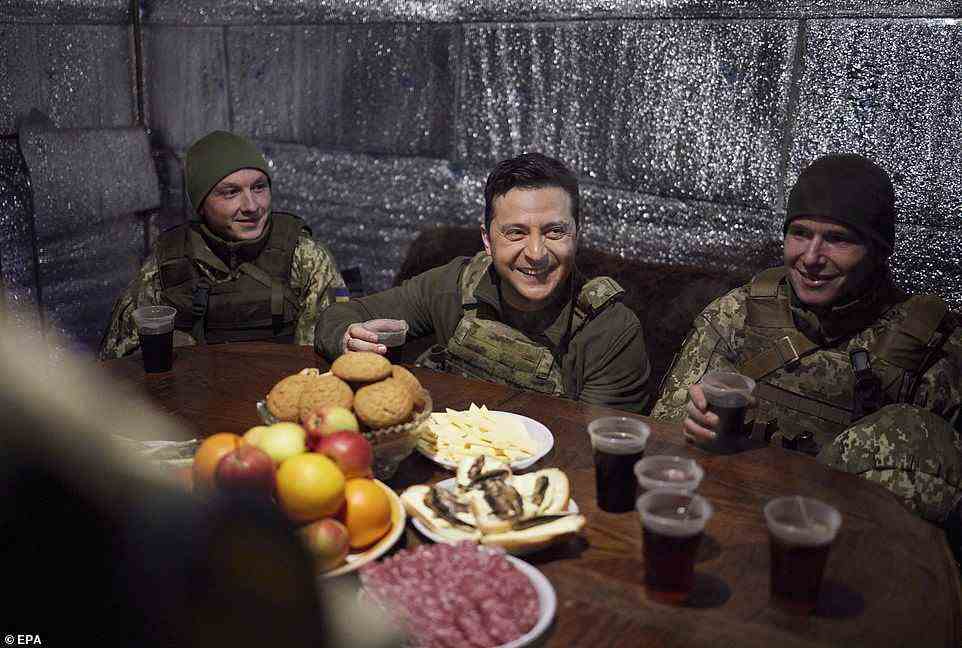
Ukrainian President Volodymyr Zelensky visited soldiers stationed not far Donetsk, a city controlled by pro-Russian militants, on Thursday as the US warned that Russia’s President Putin might launch a chemical weapons attack before invading Ukraine
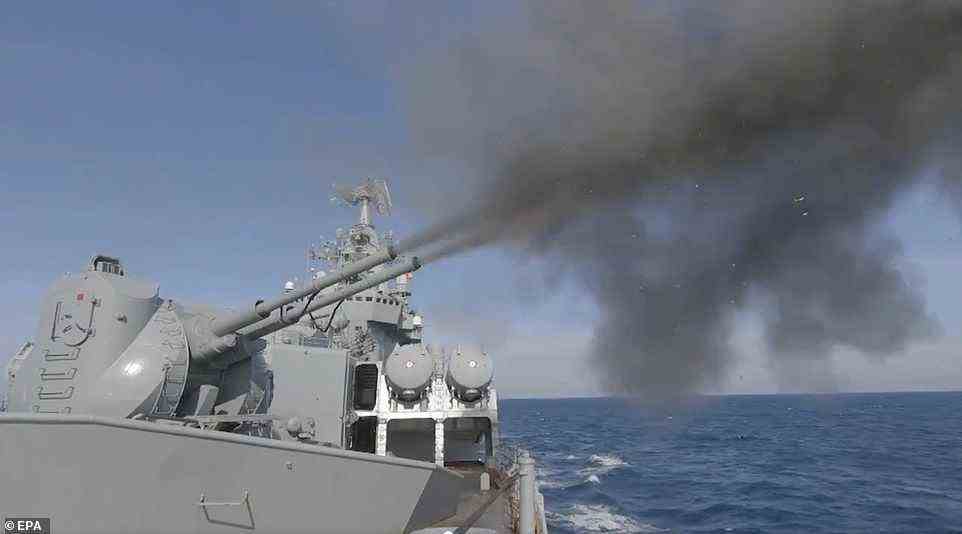
Russian cruiser Moskva of the Black Sea Fleet opens fire with its main guns during combat drills around Crimea on Friday
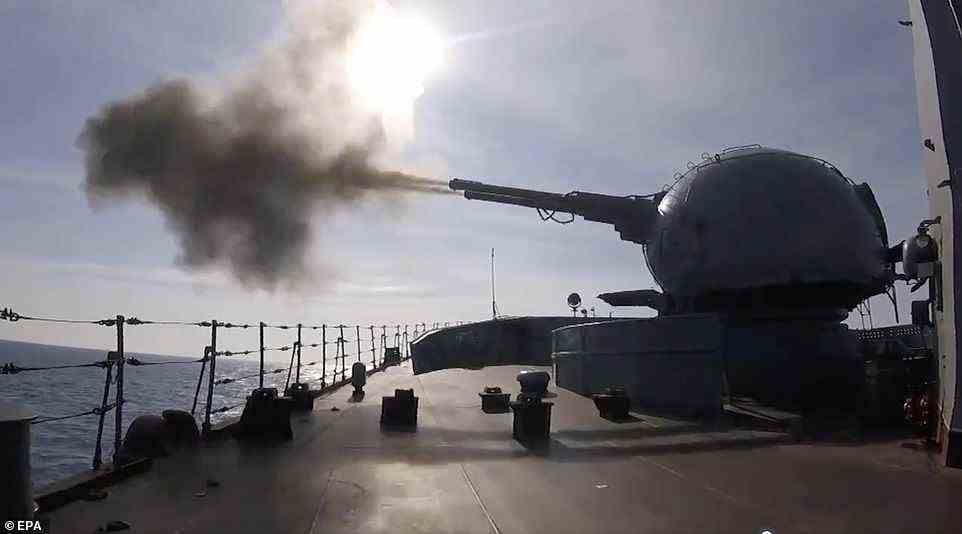
An image released by the Russian Defence Ministry shows cruiser Moskva of the Black Sea Fleet taking part in combat drills
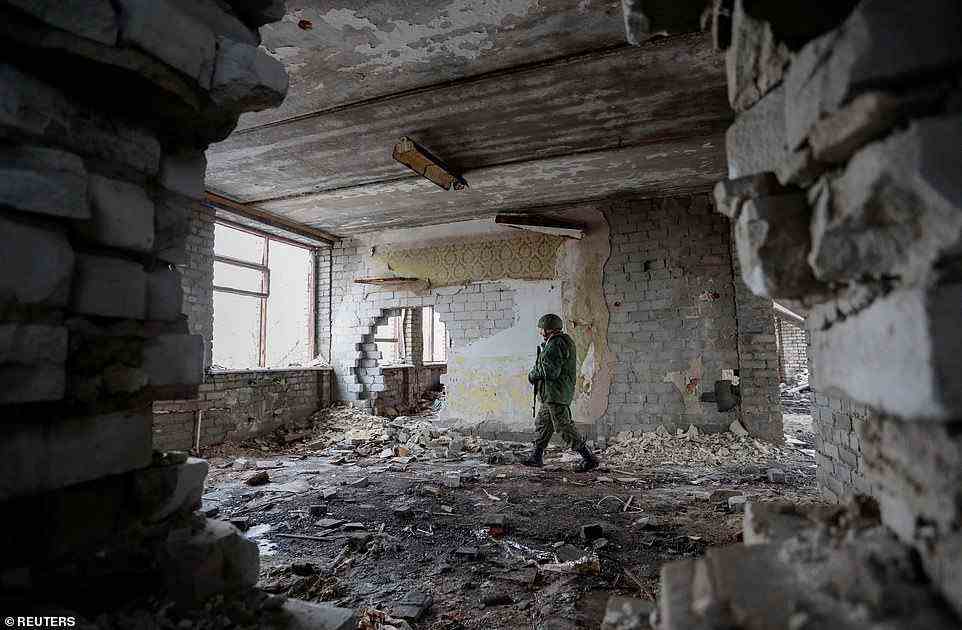
Russian-backed rebel troops inspect damaged buildings near the frontlines with Ukrainian troops, as conflict monitors say there has been a dramatic uptick in clashes in the last 24 hours
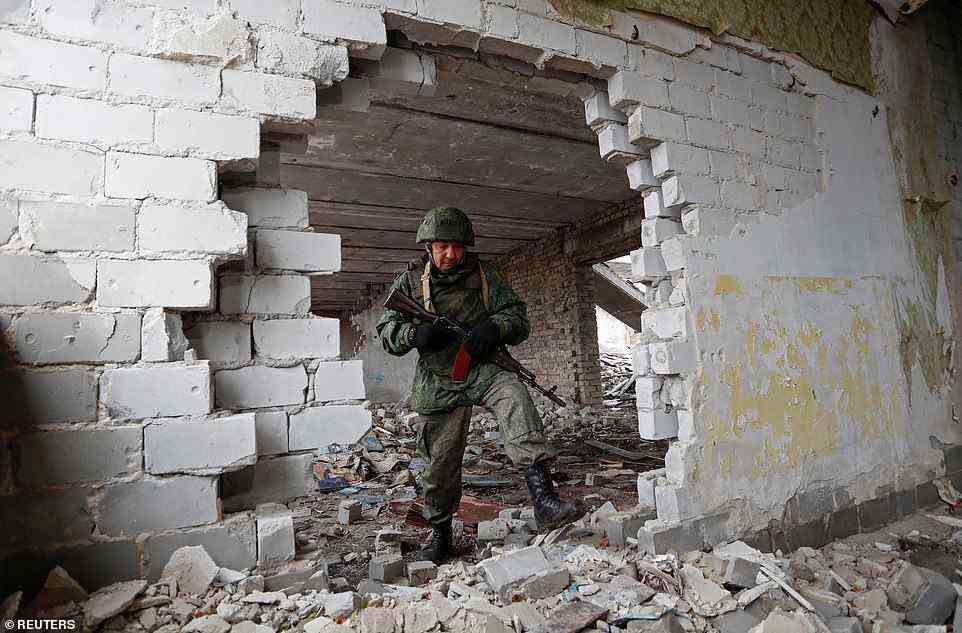
A member of the Russian-backed rebel forces in eastern Ukraine patrols through a damaged building during an uptick in clashes along the frontline that each side blames on the other

A military helicopter fires flying over the Osipovichi training ground during joint training exercises with Belarus on Thursday
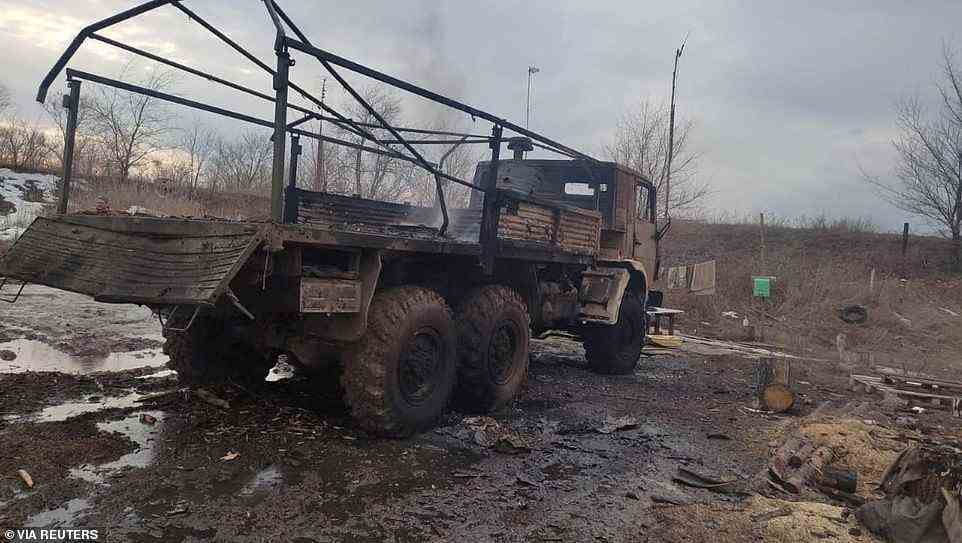
A burned-out military truck is seen on the Ukrainian side of frontlines with Russia rebel forces in the country’s east, as Kiev says it was hit by artillery fired by separatists
Ukraine said there were 60 incidents of shelling along virtually the whole of the frontline Thursday, the most-active day of attacks since 2018. Shelling continued early Friday, according to witnesses.
International monitors tasked with keeping the peace reported more than 300 explosions in 24 hours ending Thursday, around four times as many as an average day over the past month.
Sergei Lavrov, the Russian foreign minister, on Friday accused monitor groups of lying about what is happening in eastern Ukraine and accused Ukrainian forces of firing with banned weapons.
Rebel commanders also claim they are being shot at by Ukrainian forces, but Kiev has rubbished the claim – saying they are the ones under ‘unprovoked’ attack.
The village of Stanytsia Luhanska suffered more than its share of explosions on Thursday. One shell crashed into a kindergarten, blasting a hole in the wall that sent soccer balls flying off the classroom shelves just as the school day started. Others blasted craters into the schoolyard and shattered windows of nearby homes.
‘We heard the sound of broken glass. The children were very scared. Some kids started crying immediately, and the explosions continued for the next 20 minutes,’ said Olena Yaryna, the school director.
At Valentyna Melnychenko’s nearby home, the explosions filled her living room and hall with smoke.
‘I switched off the TV, and there were seven more shellings and then it stopped,’ she said as she surveyed the damage outside, her hair covered in a bright pink scarf that contrasted with the gray debris behind her.
Three people were wounded and half the village lost power. Oleksandr Pavliuk, a Ukrainian army commander, said the explosions were intended to provoke a response and ultimately a counter-response, echoing the warnings from the United States.
Monitors from the Organization for Security and Cooperation in Europe have been in place in the Donetsk and Luhansk regions since 2014 to try and maintain the cease-fire. But even they were drawn into the fray this week.
In addition to the explosions, the organization recorded nearly 600 cease-fire violations over the course of a day, more than double the average for the past month. And three of the organization’s small surveillance drones went astray after the GPS signal was jammed; a fourth couldn’t make it off the ground without a signal.
Electronic interference went further overnight, when the cellphone network went down in Luhansk for hours, for the second night in a row, according to an Associated Press journalist working in the area.
The latest warning comes after a day of fraught relations after Moscow’s foreign ministry handed a lengthy document to the US ambassador to Russia demanding that all of Washington’s weapons in central and eastern Europe and the Baltics be removed – along with all weapons already sent to Ukraine – and repeated demands that Ukraine is banned from joining NATO.
In the document, which the US is expected to reject, Moscow accused Washington of failing to respond constructively to the demands it presented in December, including for a halt to the eastern enlargement of NATO.
Russia’s ‘red lines’ were still being ignored, it said in a riposte to US and NATO counter-proposals received last month.
At the same time, the US deputy ambassador to Moscow was expelled – prompting Joe Biden to say he now expects Russia to invade Ukraine in a ‘matter of days’ and that he will not be speaking to Putin in the meantime.
Blinken was in New York on Thursday after pushing back his plans to travel to the Munich Security Conference, which is likely to be the focus of international diplomacy for the next few days.
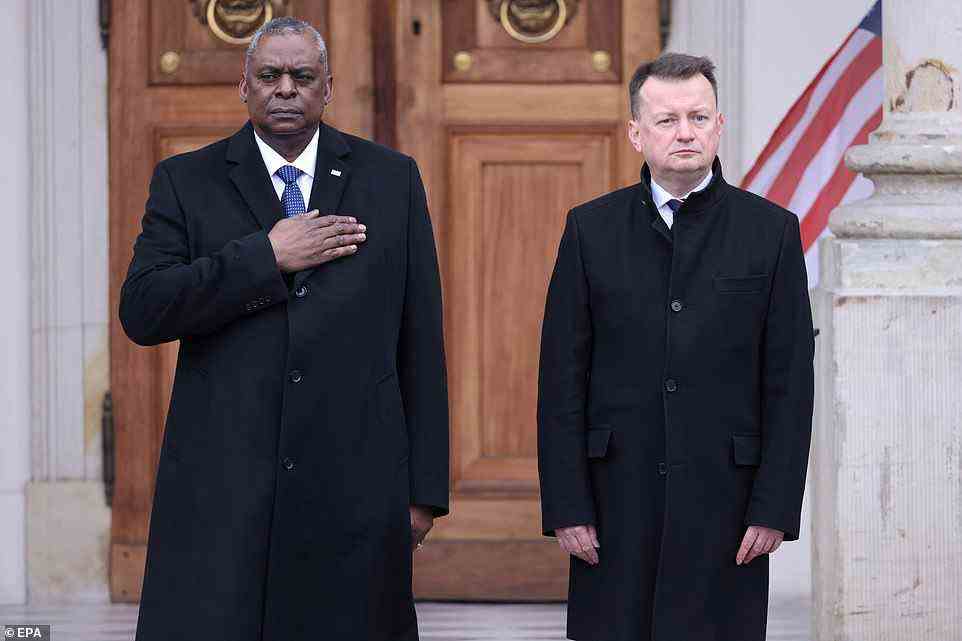
Lloyd Austin and Polish Defense Minister Mariusz Blaszczak attend a welcoming ceremony at the Lazienki Park in Warsaw
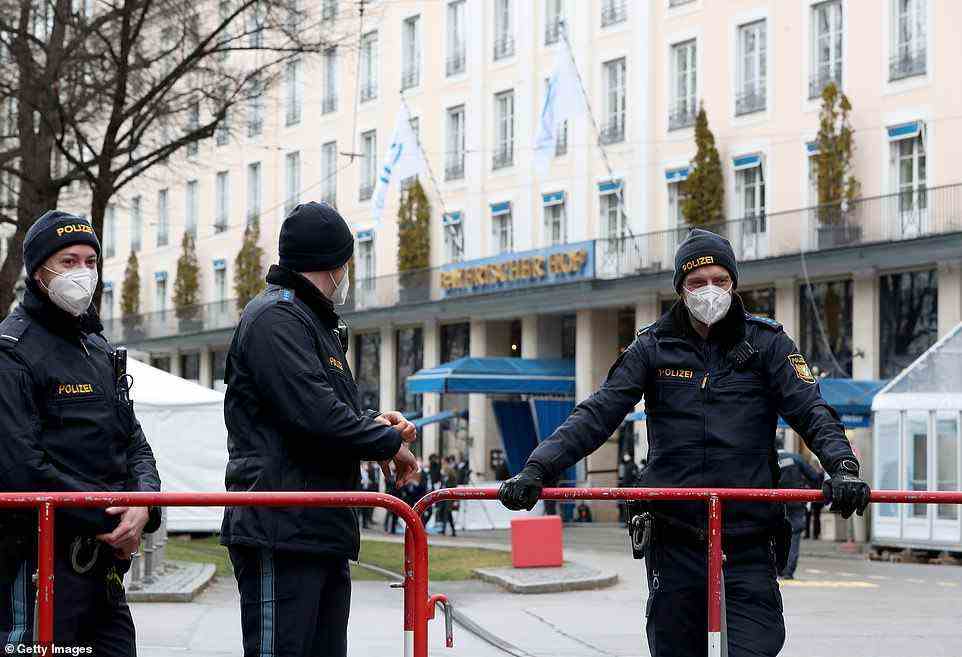
German police officers stand guard at a perimeter fence set up around the Bayerischer Hof hotel in Munich where a security conference will take place today

A police officer with a dog patrols the grounds around the Bayerischer Hof hotel in Munich, where a security conference will take place today with Ukraine high on the agenda
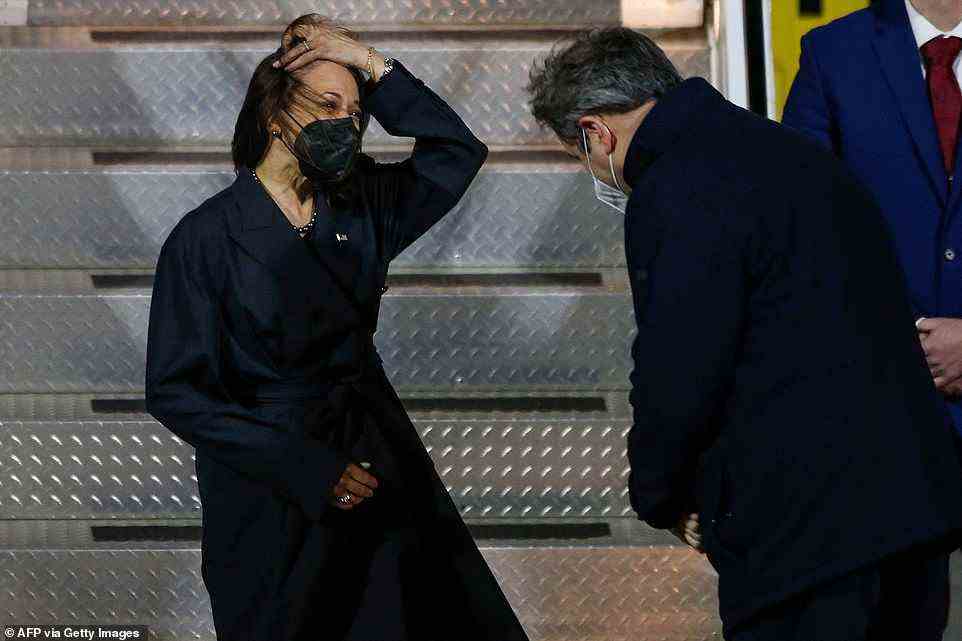
US Vice President Kamala Harris is greeted by Bavaria’s State Premier Markus Soeder as arrives at the airport in Munich, southern Germany, ahead of the conference
He laid out what Washington knew of Kremlin planning, starting with a ‘manufactured provocation and theatrical emergency meetings of the Russian government.
Next would come a promise to protect Russians in Ukraine, before cuber attacks and air strikes would begin. Tanks and soldiers would then move on key targets, including Kiev.
His purpose, he said, in laying out the intelligence findings was to persuade Putin to follow a different course.
Instead he demanded that Moscow issue an unequivocal promise that it will not invade Ukraine.
‘The Russian government can announce today, with no qualification, equivocation or deflection, that Russia will not invade Ukraine,’ he said.
‘State it clearly. State it plainly to the world, and then demonstrate it by sending your troops, your tanks, the planes back to their barracks and hangars and sending your diplomats to the negotiating table.’
In response, Russian Deputy Foreign Minister Sergei Vershinin said Blinken’s scenarios were ‘regrettable.’
‘I would even go so far as to say that they are dangerous because they bring in more tension into the unready tense atmosphere,’ he said, while repeating Moscow’s claims that some troops were already heading home after completing drills.
Earlier he called on the gathered foreign ministers not to turn the meeting into a ‘circus’ or use it to spread ‘baseless accusations.’
Blinken, speaking in front of the UN Security Council on Thursday, said: ‘As we meet today the most immediate threat to peace and security is Russia’s looming aggression against Ukraine.
‘The stakes go far beyond Ukraine. This is a moment of peril for the lives and safety of millions of people.’
‘This crisis directly affects every member of this council and every country in the world because the basic principles that sustain peace and security – principles that were enshrined in the wake of two world wars and the Cold War – are under threat,
‘The principle that one country cannot change the borders of another by force. The principle that one country cannot dictate another’s choices or policies or with whom it will associate. The principal of national sovereignty.’
The Russian document sent to the US ambassador on Thursday listed a series of demands to de-escalate the situation around Ukraine.
These included a halt to Western weapons supplies and removal of those already sent, the withdrawal of Western military advisers and instructors from Ukraine, and a halt to any joint NATO exercises with Ukraine.
‘In the absence of the readiness of the American side to agree on firm, legally binding guarantees of our security from the United States and its allies, Russia will be forced to respond, including through the implementation of military-technical measures,’ the document said.
Russia has suggested in the past that ‘military-technical measures’ could include missile and troop deployments.

